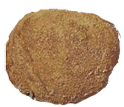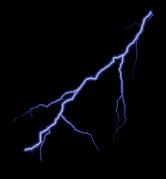
The Lightning and the Truffle
 Absorption of nitrates by the plant is enhanced considerably
by the truffle, because the truffle’s mycelia and ascocarps
reduce nitrate at a much higher rate than the rootlets of the plant
alone. This is believed to play an important role in the release of
spores. It may also provide at least a partial explanation for the
persistent observation made by desert truffle collectors that strong
lightning during rainy thunderstorms in fall will bring out the
truffles in large quantities during the spring. Nitrogen is an abundant
element. About 80% of the air is nitrogen. Inorganic nitrogen may exist
in the free state as nitrite (NO2-), nitrate (NO3-), or ammonia (NH3+).
It can also exist in the free state as a gas (N2). During a rainstorm
accompanied by lightning, a very high electrical potential is
discharged instantaneously, and nitrogen can be dissociated to nitrogen
atoms or nitrogen free radicals. The atoms and free radicals can form
nitrogen compounds with water molecules, which include hydrogen,
oxygen, and nitrogen atoms. These compounds are water soluble and are
dissolved in the water drops surrounding them, which in turn carry them
down to the ground. The hydrogen-nitrogen-oxygen compounds have ionic
nature, and can easily form potassium salt, natrium salt, and other
cationic metal salts once they hit the ground where these metal cations
Absorption of nitrates by the plant is enhanced considerably
by the truffle, because the truffle’s mycelia and ascocarps
reduce nitrate at a much higher rate than the rootlets of the plant
alone. This is believed to play an important role in the release of
spores. It may also provide at least a partial explanation for the
persistent observation made by desert truffle collectors that strong
lightning during rainy thunderstorms in fall will bring out the
truffles in large quantities during the spring. Nitrogen is an abundant
element. About 80% of the air is nitrogen. Inorganic nitrogen may exist
in the free state as nitrite (NO2-), nitrate (NO3-), or ammonia (NH3+).
It can also exist in the free state as a gas (N2). During a rainstorm
accompanied by lightning, a very high electrical potential is
discharged instantaneously, and nitrogen can be dissociated to nitrogen
atoms or nitrogen free radicals. The atoms and free radicals can form
nitrogen compounds with water molecules, which include hydrogen,
oxygen, and nitrogen atoms. These compounds are water soluble and are
dissolved in the water drops surrounding them, which in turn carry them
down to the ground. The hydrogen-nitrogen-oxygen compounds have ionic
nature, and can easily form potassium salt, natrium salt, and other
cationic metal salts once they hit the ground where these metal cations
 are available. Some of these nitrogen-hydrogen-oxygen metal salts are
effective fertilizers. Those could be present in much higher
concentrations in the soil after massive lightning and thunder
rainstorms have occurred. It is known that fungi require nitrogen
compounds in order to initiate fruiting. Maybe the persistent claim
made by many local collectors that truffles abound in the areas hit by
strong lightning and thunder rainstorms, has a scientific base. The
Bedouins of the Negev even call desert truffles ‘the thunder
fungus’.
are available. Some of these nitrogen-hydrogen-oxygen metal salts are
effective fertilizers. Those could be present in much higher
concentrations in the soil after massive lightning and thunder
rainstorms have occurred. It is known that fungi require nitrogen
compounds in order to initiate fruiting. Maybe the persistent claim
made by many local collectors that truffles abound in the areas hit by
strong lightning and thunder rainstorms, has a scientific base. The
Bedouins of the Negev even call desert truffles ‘the thunder
fungus’.
- Juliet O. Ewaze, Menhel M. Al-Naama, Studies on Nitrogen Metabolism of Terfezia spp. and Tirmania spp., Phytologist, Vol. 112, No. 3 (Jul., 1989)
- Stamets, Paul, Mycelium Running, Ten Speed Press, 2005
- Kagan-Zur, Varda, Terfezias – a Family of Mycorrhizal Edible Mushrooms for Arid Zones, Uppsala, Sweden, July 3-4, 1998,
Please click here to return to Tom Volk's Fungus of the Month for January 2007 or click "back" on your browser.
Please click TomVolkFungi.net for the rest of Tom Volk's pages on fungi